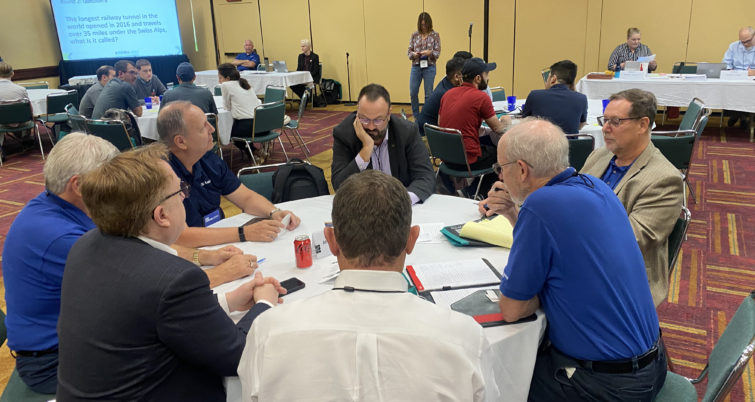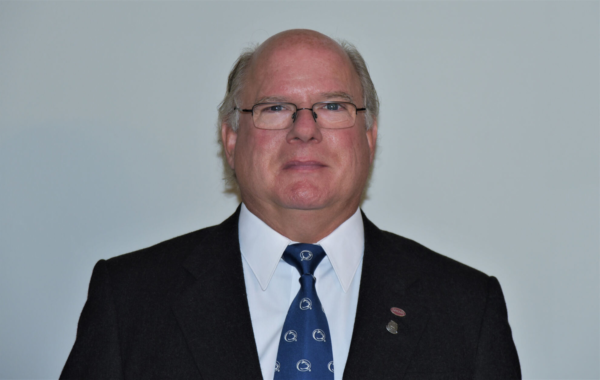From the Editorial Board: Association Participation = Unmatched Professional Development
Written by Bill Riehl, RT&S Editorial Board Member

2023 has been an exciting year for the evolution of Railway Track & Structures. Specifically, RT&S appointed an editorial board to support David Lester’s mission to keep RT&S as the premier source for current railroad engineering topics and news. As announced in the August issue, I have the honor of joining the Board as the American Railway Engineering and Maintenance of Way Association (AREMA) representative with my assumption of that association’s Senior Vice President role. This marks another step in my ongoing journey to give back to an industry that has meant so much for my own personal and professional development.
Active participation in your professional association provides leadership and professional development opportunities that can’t be matched in your typical day job. In my case, concurrent with my railroad career I spent almost 42 years in the reserves and retired last year as a Colonel. I can say that leading in a contested environment or humanitarian crisis is easy compared to leading a technical committee made up of experienced volunteers. In the military there is a service obligation and a rank structure. This allows the leader to focus on drawing the best out of the team. In a technical committee, you first have to keep the volunteers with their strong opinions in the room before you can even think about advancing the work of the committee. As you learn to do that you bring soft skills and technical knowledge back to your day job. Yes, it is hard work and it takes dedication of your time and effort outside of work, but I will use my own journey through AREMA leadership to highlight the benefits of being active in your association.
First let me address the concern with the commitment it takes to advance through the AREMA leadership ranks. Yes, it can take up to 15 years to advance through the committee leadership positions of Secretary, Vice Chair, Chair and the Functional Group positions of Director and Vice President, plus another three years for the Senior Vice President, President and Past President. However, if your goal is to be active in you association over the span of your career, then advancing through these positions is a natural progression that compliments your professional progression. As my own progression illustrates, if your are willing to step into the fray and accept the challenge, you will find this time goes by fast.
My railroad engineering life started during my practice senior year at Penn State (yes, I crammed a four-year degree into five) when I took their 400 level Railroad Engineering course to learn how to build a better model train layout. Thirty-seven years later I look back and wonder the direction of my career if I hadn’t had that initial exposure to the industry that led me to look at the job offerings in the back of this magazine and others. Over the subsequent years I moved between consultants, contractors, shortlines, regionals and now the largest shortline holding company in the world. While a structural engineer by education, the first half of my career was spent on the track side of maintenance-of-way. When I returned to consulting in 2000, I also returned to my structures roots. Through all of this, the one thing that remained constant was the relationships I built along the way.
For the seasoned reader in the audience this may be familiar ground. For the young engineer just getting started, hopefully there is a nugget of value here. In 1987 upon graduation, I hired in with a consulting firm in downtown Philadelphia that has since faded away. However, I had a great supervisor that pushed membership in the American Railway Engineering Association (AREA) and we attended the spring 1988 conference in Chicago. That set the hook. Because of the academic network I was introduced to in college, I joined Committee 24: Education and was in awe of the millennia of combined experience on the committee. It was an instant network of like-minded rail industry professionals that genuinely welcomed the “new kid”. In 1989 I joined the American Railway Bridge and Building Association for the same reasons. Over the next few years, I struggled with travel authority to attend
committee meetings and the conferences, but by the early 1990’s I was back in the saddle with another supervisor that encouraged and fully supported not only committee participation but conference attendance as well. In 1994 I joined the Roadmasters and Maintenance of Way Association. In 1997 these associations, along with committee functions of the Communications and Signals Division of the Association of American Railroads (AAR), were merged to form AREMA as we know it today.
As my career progressed so did my need for education around, and solutions for, more complex problems. AREMA and its predecessor organizations filled this need. Certainly, the technical presentations and proceedings are an excellent educational resource. However, the added value, in my opinion, comes from working with your peers in on Committees to codify best practices into the manuals and other publications. These peers become part of the network you turn to when troubleshooting a particularly stubborn problem. It is amazing the number of problems that have been solved on a bar napkin after a simple question sparks a serious conversation.
In the mid 1990’s I was assigned responsibilities for an in-house concrete crosstie manufacturing operation. While I had working knowledge of employing crossties in high speed, heavy tonnage freight mainline, I knew little about the manufacturing side of the product. This led me to join AREA Committee 10: Concrete Ties right before the formation of AREMA. With the merger, AREA Committees 3: Crossties and 10: Concrete ties were merged into AREMA Committee 30: Ties. Each of the factions within the Committee knew what their ties could do, but nowhere had anyone determined what crossties, of any material, needed to do to successfully transmit the wheel loads from the rail into the underlying ballast and subgrade. This was exciting work that ultimately led me to become the committee Secretary. While I underestimated the workload that came with the position, there was instant credibility within the committee as I became responsible for tracking and documenting the Committee’s membership participation and work product.
Around 2000, I was approached by the Committee: 24 Education and Training leadership to join the committee and fill the Vice Chair vacancy. The committee was in the throes of writing the Practical Guide to Railway Engineering and building is companion seminar Introduction to Practical Railway Engineering. While at this point I had over 19 years military service and had a solid record of leading Air Force Civil Engineers in deployments on three continents, as mentioned above, technical committee leadership is completely different. At the time there were approximately 70 members on the committee with combined experience well over 1,400 years, all with very strong opinions based on their varied backgrounds. Nevertheless, they all had one goal of building the best education materials possible. Once you harness that drive, it is rewarding to see what can happen. Very few workplace environments provide a leadership opportunity of this magnitude where you can steer a large, diverse team from an initial concept through delivery of a significant project that remains a signature piece of AREMA educational content.
In 2007 when I accepted the precursor to my current position, I became responsible for a slew of timber structures. Railroad timber structures is a topic that is not even mentioned in typical collegiate timber design classes. Once again, I needed to expand my knowledge in a new area of responsibility. AREMA Committee 7: Timber Structures provided the answer and I joined Subcommittee 3 – Construction, Maintenance & Inspection of Timber Structures.
It was me volunteering for the leadership roles on these committees that opened the opportunity to serve on the AREMA Board of Directors. In 2017 I joined the Board as a Director in the Structures Functional Group and then became the Group’s Vice President in 2020. Now as I start my term as AREMA Senior Vice President I am humbled to follow in the footsteps of those great railroad engineers that I grew up admiring for their leadership and drive to make the Associations better prepared to answer the industry’s needs. My goal is to continue that work. There are a number of exciting projects underway; these are just the highlights: Codifying Sustainability and Resiliency principles in our manuals and publications; Invigorating the seminar and symposium offerings; Modernizing the Annual Conference; Advancing outreach to underrepresented engineers and engineering specialties in our industry; Growing the Educational Foundation (which supports scholarships for the next generation) and its impact; Redeveloping the Strategic Plan so that AREMA remains relevant well into the future.
Biography: Bill Riehl is Genesee & Wyoming’s Chief Engineer Structures where he is responsible for overall structure safety management for the more than 10,000 track carrying structures and tunnels owned and operated by the G&W family of Railroads in North America. A Structural Engineer graduate of the Pennsylvania State University in 1987, he worked several positions with railroad consultants, contractors, shortline and regional railroads including Florida East Coast Railway and RailAmerica. He earned a Master of Science in Industrial and Systems Engineering from the University of Florida in 2003. He is a licensed professional engineer in Florida, Ohio and Wyoming. He currently is the AREMA Senior Vice President 2023-2024 and will be President of AREMA 2024-2025. In addition, he is a member of the Conference Operating Committee, Committee 7 – Timber Structures and Committee 24 – Education and Professional Development and is a Fellow in the Society of American Military Engineers (SAME).





